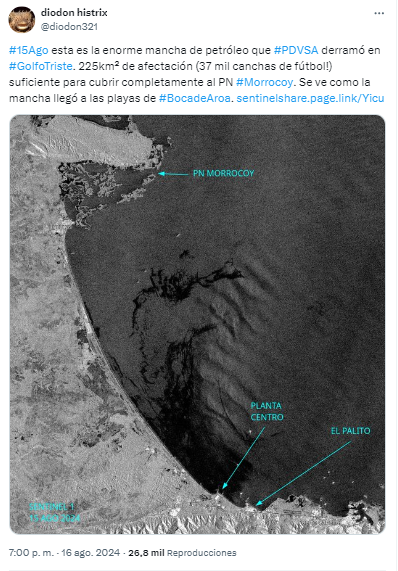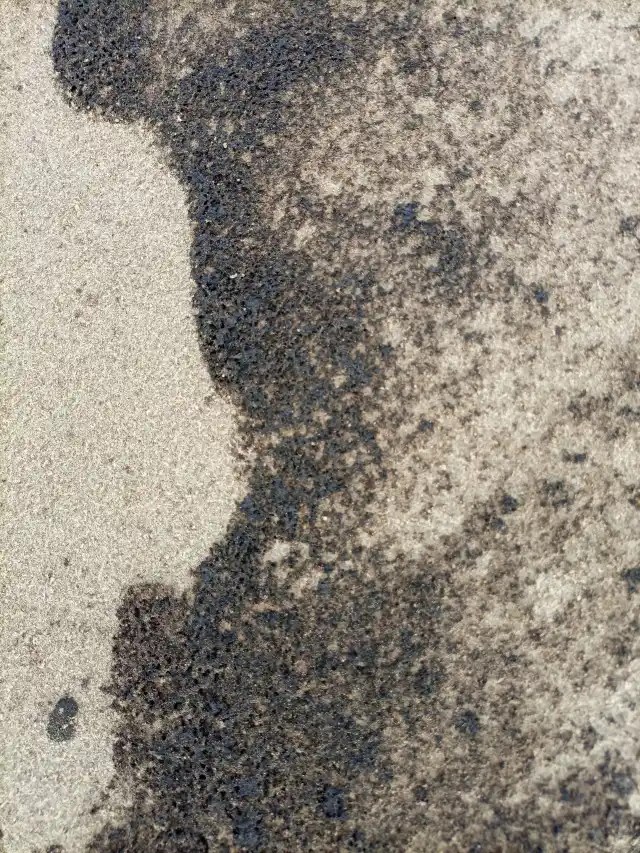
Almost two weeks after extensive oil stains began to be observed on the beaches of Carabobo and Falcón states, there has still been no official statement on this matter despite the fact that the inhabitants of these fishing settlements have denounced the environmental damage, contamination of unique habitats and their species, damage to boats and ‘chinchorros’ (artisanal casting nets), both work instruments of the inhabitants of these coasts.
lapatilla.com
Days before the fishermen reported the presence of crude oil in Boca de Aroa, Silva municipality of Falcón State, for several days large quantities of fish arrived on the shores, which allowed them to easily catch fish, save for their families’ consumption and sell at reasonable prices. It was easy enough to cast a basket or a net in the water and in minutes it was already full. According to the inhabitants of this area, the school of fish on the shore could have been a consequence of the spills, since the fish fled the presence of the hydrocarbon.
According to Eduardo Klein, biologist and director of the Remote Sensing Laboratory of the Simón Bolívar University, who monitors crude oil spills in Venezuela, he reported this Sunday, August 25th, through his account on X, that the enormous oil stain of the Pdvsa spill in Golfo Triste is 225 square kilometers, that is, the size of 37,000 soccer fields, which would be enough to cover all the Morrocoy National Park. Below it can clearly be seen how the stain reached the beaches of Boca de Aroa.

Residents of that town in Falcón say they have seen people cleaning the shore, while each fisherman decided to stop fishing, as well as collecting mollusks in the sand. They have dedicated themselves to beaching their boats out of the water and looking for a way to clean the crude oil. Some who had left their nets anchored, recovered them full of oil, which will be difficult to dissolve and clean.
Victoria González, director of the ‘Fundación Azul Ambientalista’ (Blue Environmental Foundation) in the state of Falcón, posted a video where she shows her concern regarding this spill, since exactly four years ago a similar spill, also coming from the El Palito refinery, affected the Morrocoy National Park and since August 17th, of this year, an oil spill has been reported again that affects the beaches of Boca de Aroa and probably part of Tucacas.
“We have a spill in progress again affecting marine flora and fauna, and sea workers. We demand again that PDVSA take immediate responsibility for this oil spill, which is related to El Palito or the ‘Planta Centro’ (Thermoelectric plant).”
She demanded that the environmental laws and safety regulations that the oil company must comply with regarding oil spills and their handling be respected, especially in areas close to sensitive coasts such as the Morrocoy National Park and its marine ecosystem, as well as the Cuare wildlife refuge. “We demand that the National Government take full responsibility for its environmental impact.”
This is not the only case

Falcón has been one of the states most affected in Venezuela by oil spills, according to the Venezuelan Observatory of Environmental Human Rights of the NGO ‘Clima 21’. In the reports released in recent years, Falcón is in second place just after Zulia State.
The organization reported that in the first half of 2023 they recorded 44 hydrocarbon spills, while in the second there were 35, for a total of 79 events, a number very similar to the previous year (2022) that recorded 81 in Venezuela, with Zulia being the entity with the most spills. It is followed by the states of Falcón, Anzoátegui, Monagas and Carabobo.
Alejandro Álvarez, director of the organization, said that for two years the crude oil spills have been monitored thanks to the unofficial available resources, such as the media, complaints through social networks and from the inhabitants of these areas.
Since 2016, neither PDVSA nor the Ministry of the Environment have provided information on the spills that occur and their effects. “Since we have been monitoring, we have noticed that the reports are very similar, which means that there are no changes or improvements.”
Another area severely affected by oil spills is the Gulf of Coro and the fishermen of the municipalities of Miranda, Buchivacoa, Carirubana and Los Taques, who have reported various spills since the end of 2019.
After multiple meetings with representatives of the regional and national governments, they agreed to an environmental study in the gulf, as well as an incentive payment for the damages caused.
Fishermen from Paraguaná confirmed that not all of them have received the payment, which ranges from 200 to 500 dollars, depending on the specialty of each sailor, and they have not had access to any of the results of the studies done in the area.
Photo 4
Venezuelan environmental disaster: new oil spill covers over 200 km² on the coasts of Falcón and Carabobo states

